2004 ISUZU TF SERIES sensor
[x] Cancel search: sensorPage 2789 of 4264
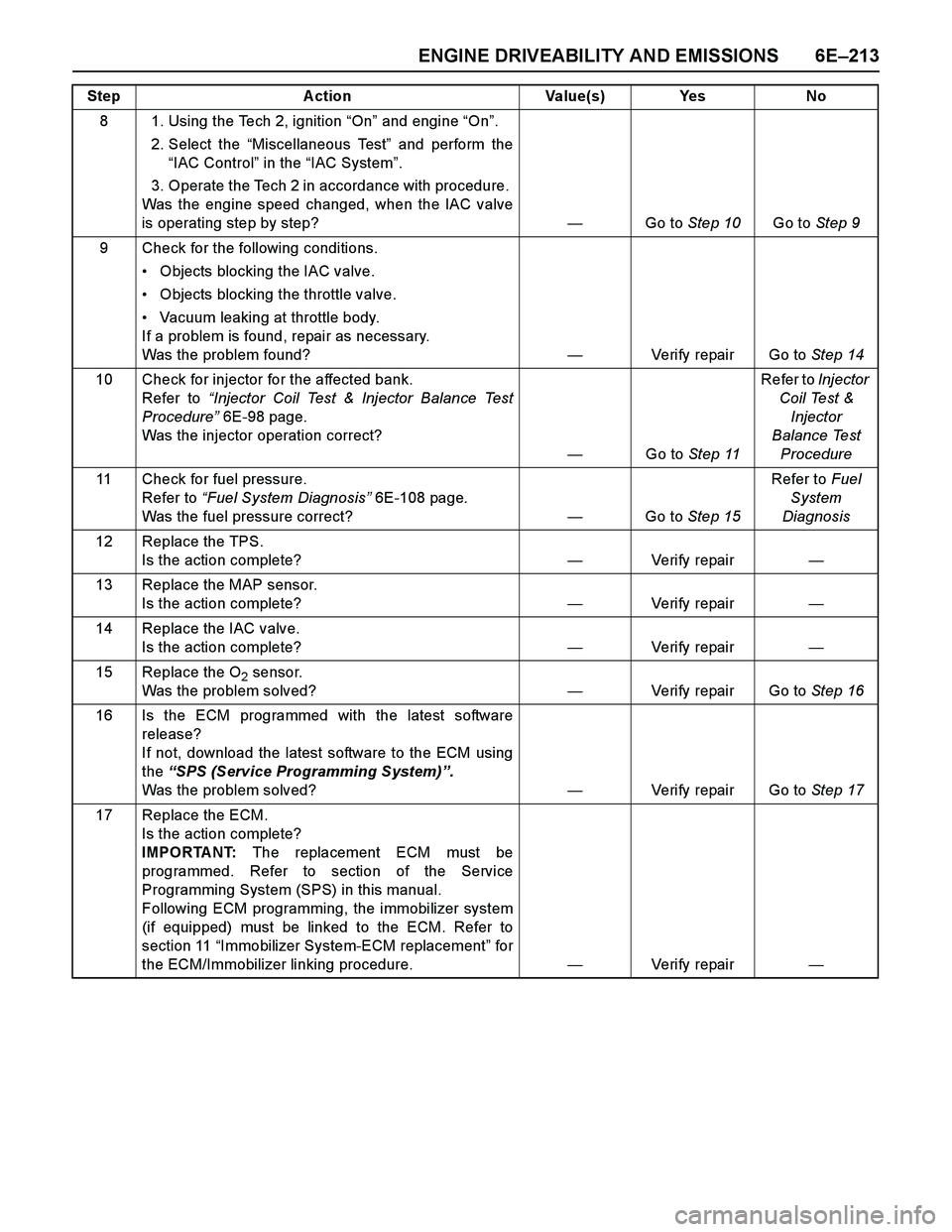
ENGINE DRIVEABILITY AND EMISSIONS 6E–213
8 1. Using the Tech 2, ignition “On” and engine “On”.
2. Select the “Miscellaneous Test” and perform the
“IAC Control” in the “IAC System”.
3. Operate the Tech 2 in accordance with procedure.
Was the engine speed changed, when the IAC valve
is operating step by step?—Go to Step 10Go to Step 9
9 Check for the following conditions.
Objects blocking the IAC valve.
Objects blocking the throttle valve.
Vacuum leaking at throttle body.
If a problem is found, repair as necessary.
Was the problem found?—Verify repair Go to Step 14
10 Check for injector for the affected bank.
Refer to “Injector Coil Test & Injector Balance Test
Procedure” 6E-98 page.
Was the injector operation correct?
—Go to Step 11Refer to Injector
Coil Test &
Injector
Balance Test
Procedure
11 Check for fuel pressure.
Refer to “Fuel System Diagnosis” 6E-108 page.
Was the fuel pressure correct? —Go to Step 15Refer to Fuel
System
Diagnosis
12 Replace the TPS.
Is the action complete?—Veri fy repai r—
13 Replace the MAP sensor.
Is the action complete?—Veri fy repai r—
14 Replace the IAC valve.
Is the action complete?—Veri fy repai r—
15 Replace the O
2 sensor.
Was the problem solved?—Verify repair Go to Step 16
16 Is the ECM programmed with the latest software
release?
If not, download the latest software to the ECM using
the “SPS (Service Programming System)”.
Was the problem solved?—Verify repair Go to Step 17
17 Replace the ECM.
Is the action complete?
IMPORTANT: The replacement ECM must be
programmed. Refer to section of the Service
Programming System (SPS) in this manual.
Following ECM programming, the immobilizer system
(if equipped) must be linked to the ECM. Refer to
section 11 “Immobilizer System-ECM replacement” for
the ECM/Immobilizer linking procedure.—Veri fy repai r— Step A ction Value(s) Yes No
Page 2790 of 4264
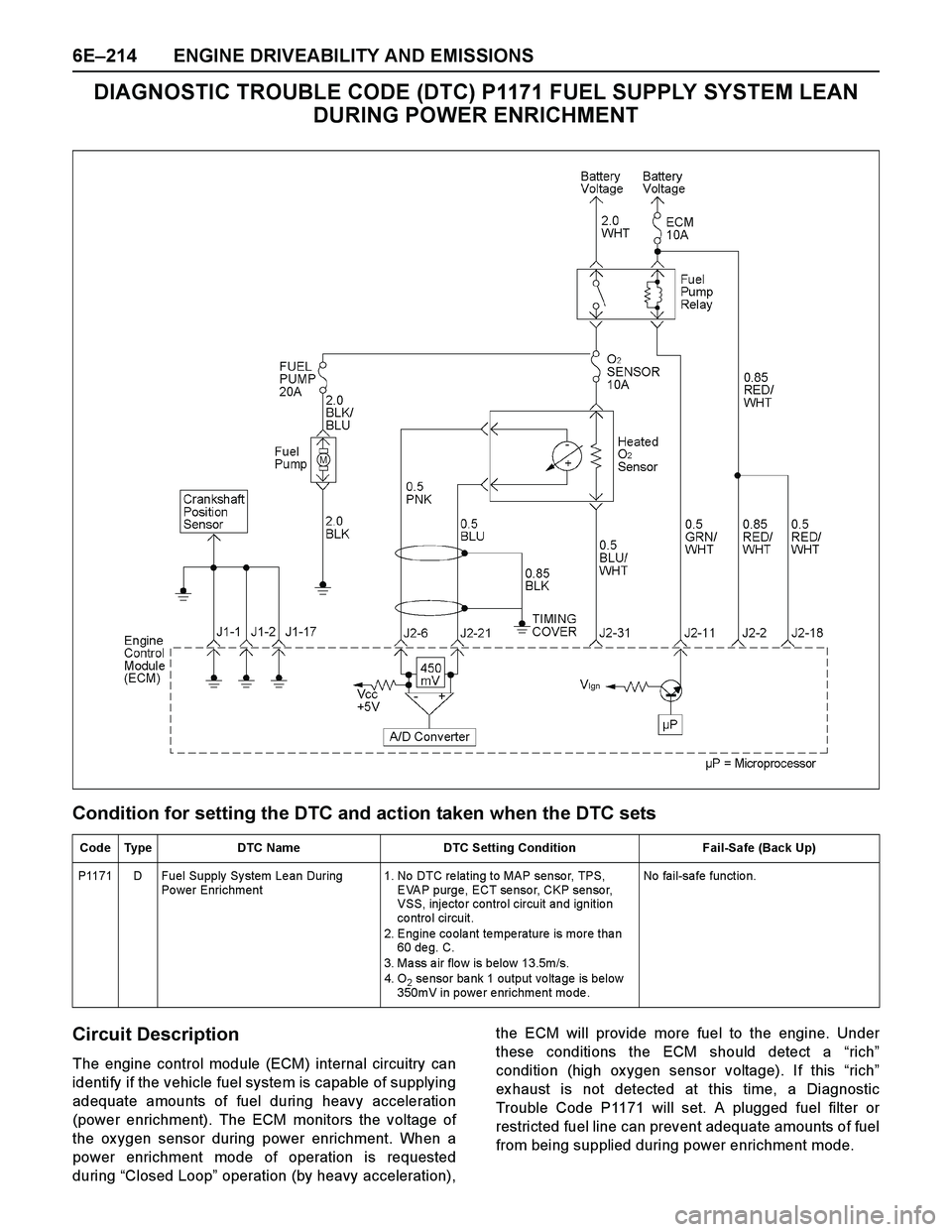
6E–214 ENGINE DRIVEABILITY AND EMISSIONS
DIAGNOSTIC TROUBLE CODE (DTC) P1171 FUEL SUPPLY SYSTEM LEAN
DURING POWER ENRICHMENT
Condition for setting the DTC and action taken when the DTC sets
Circuit Description
The engine control module (ECM) internal circuitry can
identify if the vehicle fuel system is capable of supplying
adequate amounts of fuel during heavy acceleration
(power enrichment). The ECM monitors the voltage of
the ox ygen sensor during power enrichment. When a
power enrichment mode of operation is requested
during “Closed Loop” operation (by heavy acceleration),the ECM will provide more fuel to the engine. Under
these conditions the ECM should detect a “rich”
condition (high ox ygen sensor voltage). If this “rich”
ex haust is not detected at this time, a Diagnostic
Trouble Code P1171 will set. A plugged fuel filter or
restricted fuel line can prevent adequate amounts of fuel
from being supplied during power enrichment mode.
Code Type DTC Name DTC Setting Condition Fail-Safe (Back Up)
P1171 D Fuel Supply System Lean During
Po wer Enrichment 1. No DTC re lating to MAP senso r, TPS,
EVAP purge, ECT sensor, CKP sensor,
VSS, injecto r contro l circuit and ignitio n
co ntro l circuit.
2. Engine coolant temperature is more than
60 de g. C.
3. Ma ss a ir flo w is below 13.5m/s.
4. O
2 sensor bank 1 output voltage is below
350mV in power enrichment mode. No fail-safe function.
Page 2791 of 4264
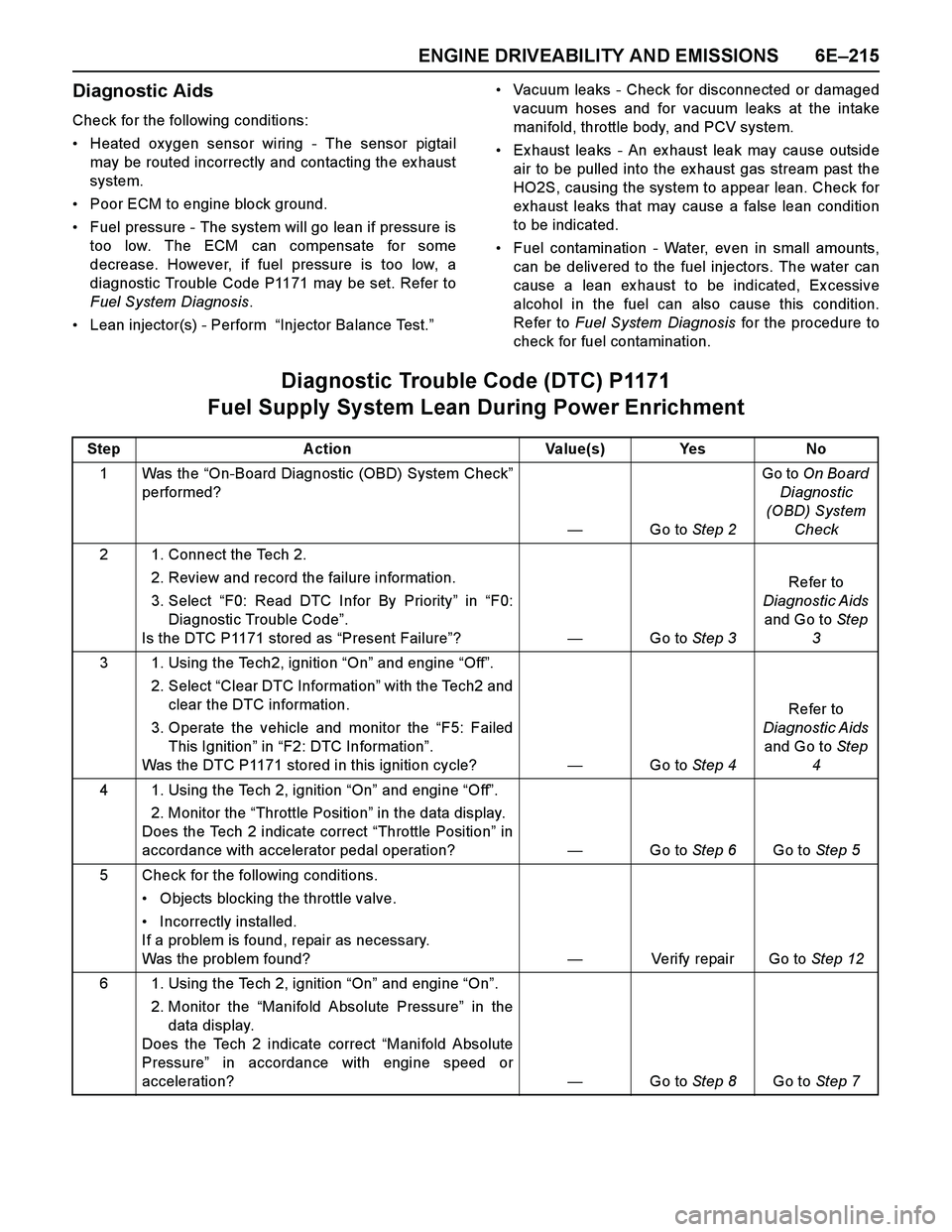
ENGINE DRIVEABILITY AND EMISSIONS 6E–215
Diagnostic Aids
Check for the following conditions:
Heated oxygen sensor wiring - The sensor pigtail
may be routed incorrectly and contacting the ex haust
system.
Poor ECM to engine block ground.
Fuel pressure - The system will go lean if pressure is
too low. The ECM can compensate for some
decrease. However, if fuel pressure is too low, a
diagnostic Trouble Code P1171 may be set. Refer to
Fuel System Diagnosis.
Lean injector(s) - Perform “Injector Balance Test.”Vacuum leaks - Check for disconnected or damaged
vacuum hoses and for vacuum leaks at the intake
manifold, throttle body, and PCV system.
Ex haust leaks - An ex haust leak may cause outside
air to be pulled into the ex haust gas stream past the
HO2S, causing the system to appear lean. Check for
exhaust leaks that may cause a false lean condition
to be indicated.
Fuel contamination - Water, even in small amounts,
can be delivered to the fuel injectors. The water can
cause a lean ex haust to be indicated, Ex cessive
alcohol in the fuel can also cause this condition.
Refer to Fuel System Diagnosis for the procedure to
check for fuel contamination.
Diagnostic Trouble Code (DTC) P1171
Fuel Supply Sy stem Lean During Power Enrichment
Step A ction Value(s) Yes No
1 Was the “On-Board Diagnostic (OBD) System Check”
performed?
—Go to Step 2Go to On Board
Diagnostic
(OBD) System
Check
2 1. Connect the Tech 2.
2. Review and record the failure information.
3. Select “F0: Read DTC Infor By Priority” in “F0:
Diagnostic Trouble Code”.
Is the DTC P1171 stored as “Present Failure”?—Go to Step 3Refer to
Diagnostic Aids
and Go to Step
3
3 1. Using the Tech2, ignition “On” and engine “Off”.
2. Select “Clear DTC Information” with the Tech2 and
clear the DTC information.
3. Operate the vehicle and monitor the “F5: Failed
This Ignition” in “F2: DTC Information”.
Was the DTC P1171 stored in this ignition cycle?—Go to Step 4Refer to
Diagnostic Aids
and Go to Step
4
4 1. Using the Tech 2, ignition “On” and engine “Off”.
2. Monitor the “Throttle Position” in the data display.
Does the Tech 2 indicate correct “Throttle Position” in
accordance with accelerator pedal operation? —Go to Step 6Go to Step 5
5 Check for the following conditions.
Objects blocking the throttle valve.
Incorrectly installed.
If a problem is found, repair as necessary.
Was the problem found?—Verify repair Go to Step 12
6 1. Using the Tech 2, ignition “On” and engine “On”.
2. Monitor the “Manifold Absolute Pressure” in the
data display.
Does the Tech 2 indicate correct “Manifold Absolute
Pressure” in accordance with engine speed or
acceleration? —Go to Step 8Go to Step 7
Page 2792 of 4264
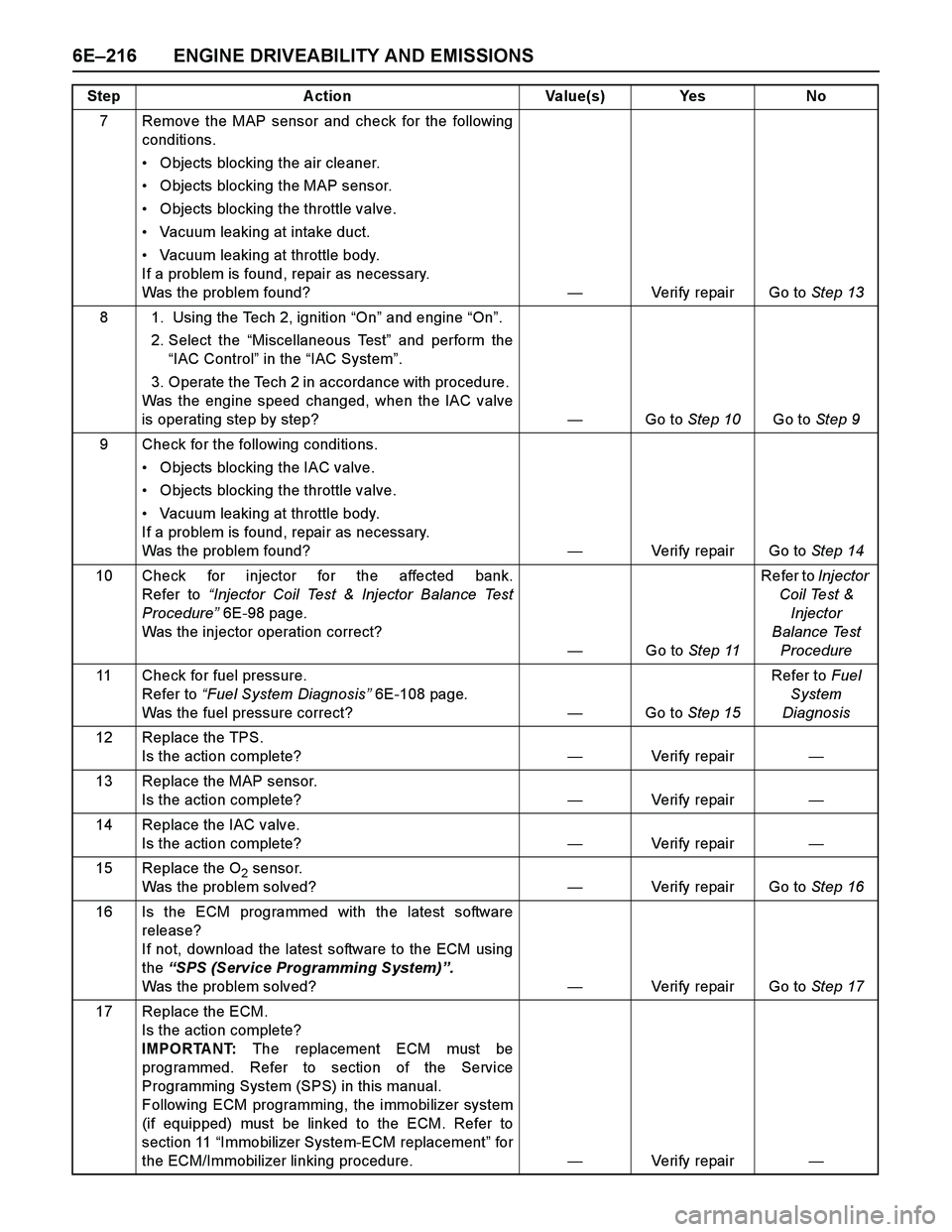
6E–216 ENGINE DRIVEABILITY AND EMISSIONS
7 Remove the MAP sensor and check for the following
conditions.
Objects blocking the air cleaner.
Objects blocking the MAP sensor.
Objects blocking the throttle valve.
Vacuum leaking at intake duct.
Vacuum leaking at throttle body.
If a problem is found, repair as necessary.
Was the problem found?—Verify repair Go to Step 13
8 1. Using the Tech 2, ignition “On” and engine “On”.
2. Select the “Miscellaneous Test” and perform the
“IAC Control” in the “IAC System”.
3. Operate the Tech 2 in accordance with procedure.
Was the engine speed changed, when the IAC valve
is operating step by step?—Go to Step 10Go to Step 9
9 Check for the following conditions.
Objects blocking the IAC valve.
Objects blocking the throttle valve.
Vacuum leaking at throttle body.
If a problem is found, repair as necessary.
Was the problem found?—Verify repair Go to Step 14
10 Check for injector for the affected bank.
Refer to “Injector Coil Test & Injector Balance Test
Procedure” 6E-98 page.
Was the injector operation correct?
—Go to Step 11Refer to Injector
Coil Test &
Injector
Balance Test
Procedure
11 Check for fuel pressure.
Refer to “Fuel System Diagnosis” 6E-108 page.
Was the fuel pressure correct? —Go to Step 15Refer to Fuel
System
Diagnosis
12 Replace the TPS.
Is the action complete?—Veri fy repai r—
13 Replace the MAP sensor.
Is the action complete?—Veri fy repai r—
14 Replace the IAC valve.
Is the action complete?—Veri fy repai r—
15 Replace the O
2 sensor.
Was the problem solved?—Verify repair Go to Step 16
16 Is the ECM programmed with the latest software
release?
If not, download the latest software to the ECM using
the “SPS (Service Programming System)”.
Was the problem solved?—Verify repair Go to Step 17
17 Replace the ECM.
Is the action complete?
IMPORTANT: The replacement ECM must be
programmed. Refer to section of the Service
Programming System (SPS) in this manual.
Following ECM programming, the immobilizer system
(if equipped) must be linked to the ECM. Refer to
section 11 “Immobilizer System-ECM replacement” for
the ECM/Immobilizer linking procedure.—Veri fy repai r— Step A ction Value(s) Yes No
Page 2804 of 4264
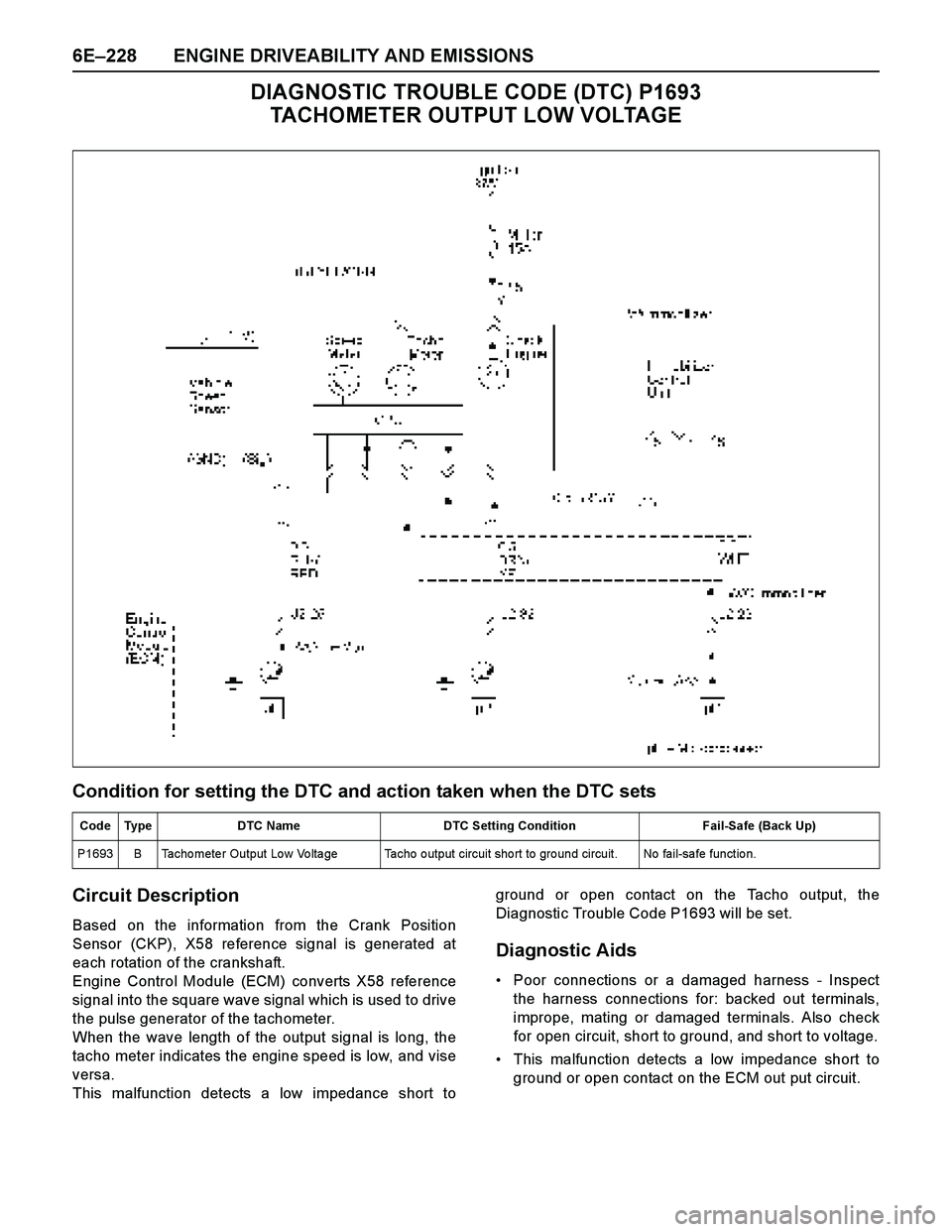
6E–228 ENGINE DRIVEABILITY AND EMISSIONS
DIAGNOSTIC TROUBLE CODE (DTC) P1693
TACHOMETER OUTPUT LOW VOLTAGE
Condition for setting the DTC and action taken when the DTC sets
Circuit Description
Based on the information from the Crank Position
Sensor (CKP), X58 reference signal is generated at
each rotation of the crankshaft.
Engine Control Module (ECM) converts X58 reference
signal into the square wave signal which is used to drive
the pulse generator of the tachometer.
When the wave length of the output signal is long, the
tacho meter indicates the engine speed is low, and vise
versa.
This malfunction detects a low impedance short toground or open contact on the Tacho output, the
Diagnostic Trouble Code P1693 will be set.
Diagnostic Aids
Poor connections or a damaged harness - Inspect
the harness connections for: backed out terminals,
imprope, mating or damaged terminals. Also check
for open circuit, short to ground, and short to voltage.
This malfunction detects a low impedance short to
ground or open contact on the ECM out put circuit.
Code Type DTC Name DTC Setting Condition Fail-Safe (Back Up)
P1693 B Tacho mete r Output Lo w Vo lta ge Tacho o utput circuit sho rt to gro und circuit. No fail-safe functio n.
Page 2805 of 4264

ENGINE DRIVEABILITY AND EMISSIONS 6E–229
Diagnostic Trouble Code (DTC) P1693 Tachometer Output Low Voltage
Step A ction Value(s) Yes No
1 Was the “On-Board Diagnostic (OBD) System Check”
performed?
—Go to Step 2Go to On Board
Diagnostic
(OBD) System
Check
2 1. Connect the Tech 2.
2. Review and record the failure information.
3. Select “F0: Read DTC Infor By Priority” in “F0:
Diagnostic Trouble Code”.
Is the DTC P1693 stored as “Present Failure”?—Go to Step 3Refer to
Diagnostic Aids
and Go to Step
3
3 1. Using the Tech2, ignition “On” and engine “Off”.
2. Select “Clear DTC Information” with the Tech2 and
clear the DTC information.
3. Operate the vehicle and monitor the “F5: Failed
This Ignition” in “F2: DTC Information”.
Was the DTC P1693 stored in this ignition cycle?—Go to Step 4Refer to
Diagnostic Aids
and Go to Step
4
4 Check for poor/faulty connection at the ECM or meter
connector. If a poor/faulty connection is found, repair
the faulty terminal.
Was the problem found?
—Verify repair Go to Step 5
5 If a oscilloscope is available, monitor the Tachometer
output signal. Does the oscilloscope indicate correct
wave form?
—Go to Step 10Not available:
Go to Step 6
Fix ed at low:
Go to Step 6
Fixed at High:
Go to Step 7
25
C-56(J2) B-24
11
Crankshaft Position (CKP) Sensor & Tacho Output Signa l
Reference Wave Form
CH1
0V
CH2
0V
Measurem ent Terminal: CH1: J1-21(+) / CH2: J2-25(+) GND(-)
Measurem ent Scale: CH1: 2V/d iv / CH2: 10V/div 5ms/div
Measurement Condition: Approx imately 2000rpm
Page 2808 of 4264
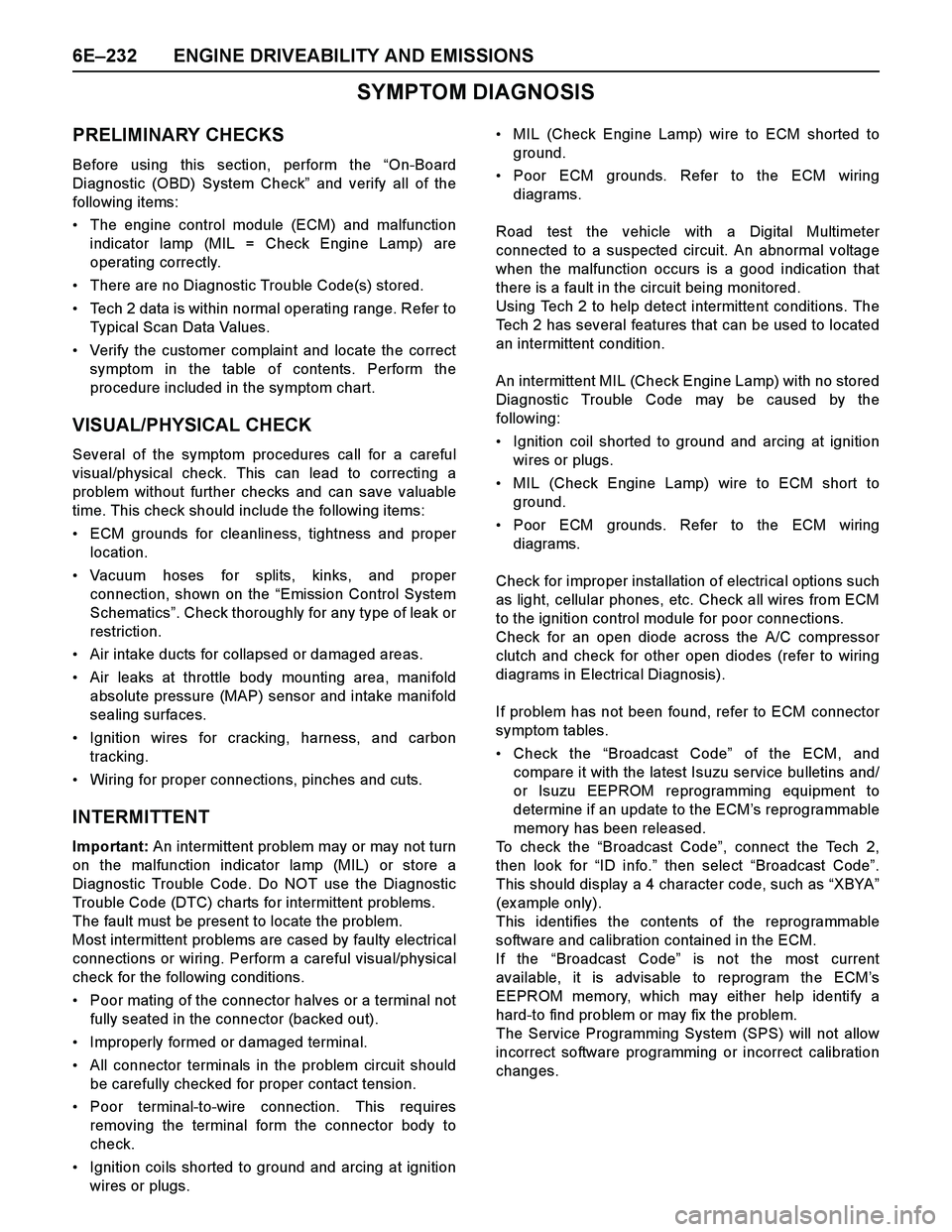
6E–232 ENGINE DRIVEABILITY AND EMISSIONS
SYMPTOM DIAGNOSIS
PRELIMINARY CHECKS
Before using this section, perform the “On-Board
Diagnostic (OBD) System Check” and verify all of the
following items:
The engine control module (ECM) and malfunction
indicator lamp (MIL = Check Engine Lamp) are
operating correctly.
There are no Diagnostic Trouble Code(s) stored.
Tech 2 data is within normal operating range. Refer to
Typical Scan Data Values.
Verify the customer complaint and locate the correct
symptom in the table of contents. Perform the
procedure included in the symptom chart.
VISUAL/PHYSICAL CHECK
Several of the symptom procedures call for a careful
visual/physical check. This can lead to correcting a
problem without further checks and can save valuable
time. This check should include the following items:
ECM grounds for cleanliness, tightness and proper
location.
Vacuum hoses for splits, kinks, and proper
connection, shown on the “Emission Control System
Schematics”. Check thoroughly for any type of leak or
restriction.
Air intake ducts for collapsed or damaged areas.
Air leaks at throttle body mounting area, manifold
absolute pressure (MAP) sensor and intake manifold
sealing surfaces.
Ignition wires for cracking, harness, and carbon
tracking.
Wiring for proper connections, pinches and cuts.
INTERMITTENT
Important: An intermittent problem may or may not turn
on the malfunction indicator lamp (MIL) or store a
Diagnostic Trouble Code. Do NOT use the Diagnostic
Trouble Code (DTC) charts for intermittent problems.
The fault must be present to locate the problem.
Most intermittent problems are cased by faulty electrical
connections or wiring. Perform a careful visual/physical
check for the following conditions.
Poor mating of the connector halves or a terminal not
fully seated in the connector (backed out).
Improperly formed or damaged terminal.
All connector terminals in the problem circuit should
be carefully checked for proper contact tension.
Poor terminal-to-wire connection. This requires
removing the terminal form the connector body to
check.
Ignition coils shorted to ground and arcing at ignition
wires or plugs.MIL (Check Engine Lamp) wire to ECM shorted to
ground.
Poor ECM grounds. Refer to the ECM wiring
diagrams.
Road test the vehicle with a Digital Multimeter
connected to a suspected circuit. An abnormal voltage
when the malfunction occurs is a good indication that
there is a fault in the circuit being monitored.
Using Tech 2 to help detect intermittent conditions. The
Tech 2 has several features that can be used to located
an intermittent condition.
An intermittent MIL (Check Engine Lamp) with no stored
Diagnostic Trouble Code may be caused by the
follow ing:
Ignition coil shorted to ground and arcing at ignition
wires or plugs.
MIL (Check Engine Lamp) wire to ECM short to
ground.
Poor ECM grounds. Refer to the ECM wiring
diagrams.
Check for improper installation of electrical options such
as light, cellular phones, etc. Check all wires from ECM
to the ignition control module for poor connections.
Check for an open diode across the A/C compressor
clutch and check for other open diodes (refer to wiring
diagrams in Electrical Diagnosis).
If problem has not been found, refer to ECM connector
symptom tables.
Check the “Broadcast Code” of the ECM, and
compare it with the latest Isuzu service bulletins and/
or Isuzu EEPROM reprogramming equipment to
determine if an update to the ECM’s reprogrammable
memory has been released.
To check the “Broadcast Code”, connect the Tech 2,
then look for “ID info.” then select “Broadcast Code”.
This should display a 4 character code, such as “XBYA”
(ex ample only).
This identifies the contents of the reprogrammable
software and calibration contained in the ECM.
If the “Broadcast Code” is not the most current
available, it is advisable to reprogram the ECM’s
EEPROM memory, which may either help identify a
hard-to find problem or may fix the problem.
The Service Programming System (SPS) will not allow
incorrect software programming or incorrect calibration
changes.
Page 2809 of 4264
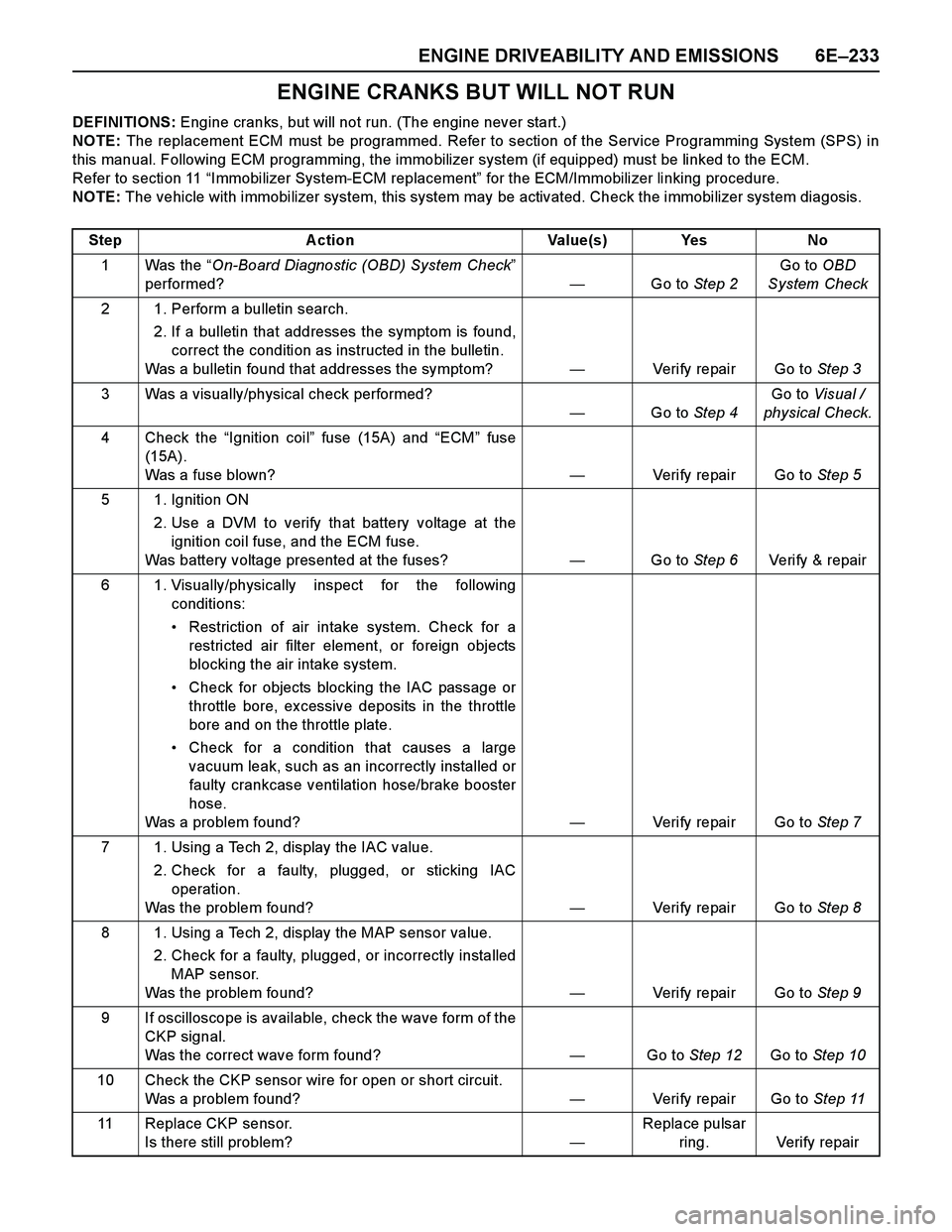
ENGINE DRIVEABILITY AND EMISSIONS 6E–233
ENGINE CRANKS BUT WILL NOT RUN
DEFINITIONS: Engine cranks, but will not run. (The engine never start.)
NOTE: The replacement ECM must be programmed. Refer to section of the Service Programming System (SPS) in
this manual. Following ECM programming, the immobilizer system (if equipped) must be linked to the ECM.
Refer to section 11 “Immobilizer System-ECM replacement” for the ECM/Immobilizer linking procedure.
NOTE: The vehicle with immobilizer system, this system may be activated. Check the immobilizer system diagosis.
Step Action Value(s) Yes No
1Was the “On-Board Diagnostic (OBD) System Check”
performed?—Go to Step 2Go to OBD
System Check
2 1. Perform a bulletin search.
2. If a bulletin that addresses the symptom is found,
correct the condition as instructed in the bulletin.
Was a bulletin found that addresses the symptom?—Verify repair Go to Step 3
3 Was a visually/physical check performed?
—Go to Step 4Go to Visual /
physical Check.
4 Check the “Ignition coil” fuse (15A) and “ECM” fuse
(15A).
Was a fuse blown?—Verify repair Go to Step 5
5 1. Ignition ON
2. Use a DVM to verify that battery voltage at the
ignition coil fuse, and the ECM fuse.
Was battery voltage presented at the fuses?—Go to Step 6Verify & repair
6 1. Visually/physically inspect for the following
conditions:
Restriction of air intake system. Check for a
restricted air filter element, or foreign objects
blocking the air intake system.
Check for objects blocking the IAC passage or
throttle bore, excessive deposits in the throttle
bore and on the throttle plate.
Check for a condition that causes a large
vacuum leak, such as an incorrectly installed or
faulty crankcase ventilation hose/brake booster
hose.
Was a problem found?—Verify repair Go to Step 7
7 1. Using a Tech 2, display the IAC value.
2. Check for a faulty, plugged, or sticking IAC
operation.
Was the problem found?—Verify repair Go to Step 8
8 1. Using a Tech 2, display the MAP sensor value.
2. Check for a faulty, plugged, or incorrectly installed
MAP sensor.
Was the problem found?—Verify repair Go to Step 9
9 If oscilloscope is available, check the wave form of the
CKP signal.
Was the correct wave form found?—Go to Step 12Go to Step 10
10 Check the CKP sensor wire for open or short circuit.
Was a problem found?—Verify repair Go to Step 11
11 Replace CKP sensor.
Is there still problem?—Replace pulsar
ring. Verify repair